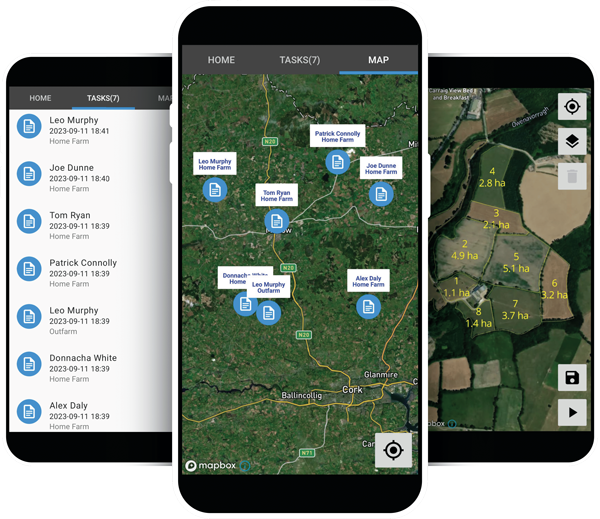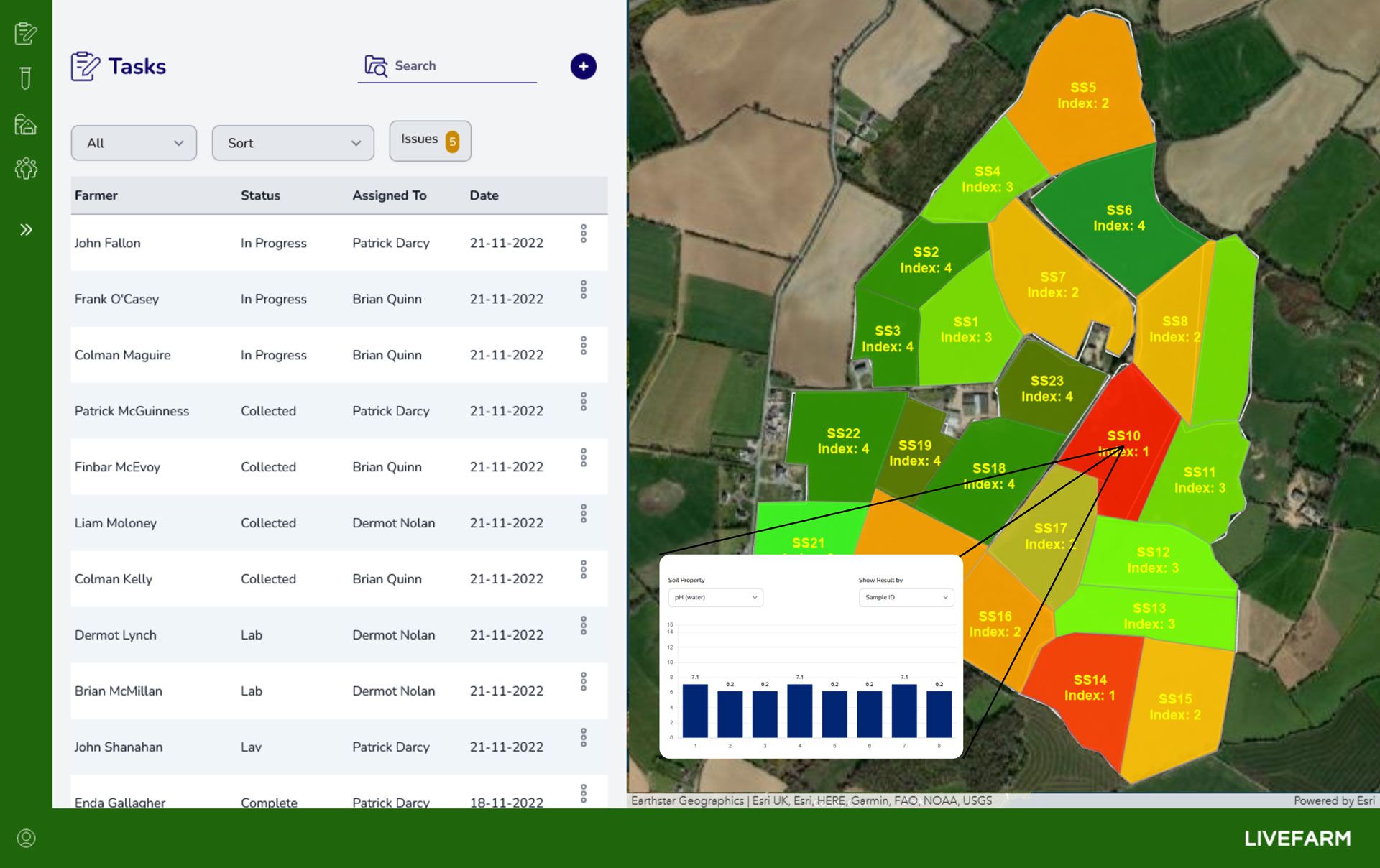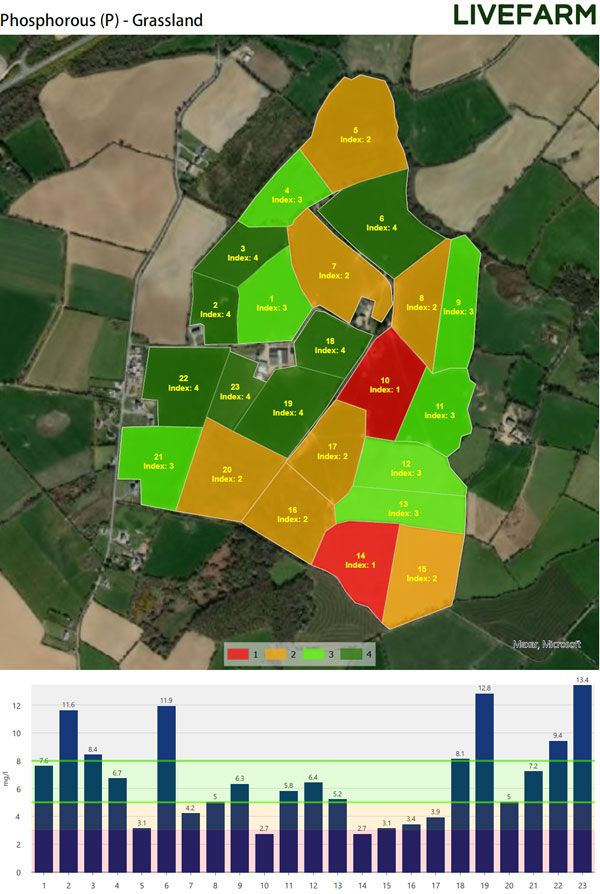Winnovating

From the cultivation techniques of the early farmers to Tull’s massive breakthrough, to the ‘tech-ricultural’ revolution that we are living through, there is no doubting the extent to which innovation has shaped agriculture and farming. For the last 13 years, an innovation arena and associated awards have been features of the annual National Ploughing Championships (The Ploughing) where problem solvers showcase their best inventions within the agricultural world. Technology, or agri-tech, has been a dominant theme of the awards, and, according to Ifac’s Irish Farm Report 2024, traditional agricultural practices have been transformed in recent years due to technology.
While this presents challenges, according to the report – costs of implementation, greater dependency on technology, data security concerns, or skills shortages – it has brought about some great advantages. Increased efficiencies, precision agriculture, data-driven decision making, and innovative crop-monitoring solutions all bring great positives, the report highlights. It explains that technology streamlines farming processes, while GPS-guided tractors and drones, for example, allow farmers to optimise resource use and minimise waste and environmental impact. Farm-management software helps farmers to analyse data on weather patterns, soil health, and crop performance, while sensors and Internet of Things (IoT) devices help monitor crop health in real-time, detecting diseases or nutrient deficiencies.
Measuring grass from space!
Kieran Holden is a grassland farmer and grassland digital specialist with Origin Enterprise, the company behind GrassMax, which was won the overall prize at the Enterprise Ireland Innovation Arena at The Ploughing in 2023. He says that the impetus to address environmental challenges while achieving sustainable land use and food production has brought about an exciting period of innovation and evolution within the agricultural sector.
GrassMax is to the fore of that evolution, as it includes technology, and is described by the company as a ‘world-first, cloud penetrating satellite technology that accurately measures the height of grass from space’. Yes, you read that right!
Kieran explains: “GrassMax offers ground-breaking insights for increasing farm productivity and profitability, while enabling organisations and businesses to verify sustainability practices in the livestock supply chain.” The associated app can help livestock farmers optimise grass utilisation, nutrient planning, and operational efficiency.
Who is Origin Enterprises?
Origin Enterprises plc, headquartered in Dublin, provides specialist advice, inputs, services and digital solutions to promote sustainable land use. Its origins trace back to the IAWS Group, before it was established as a standalone entity in 2006 to concentrate on its foundational agri-business and food sectors. The group holds leading market positions in Ireland, the United Kingdom, Brazil, Poland and Romania. It specialises in providing agronomy expertise, inputs and related services to farmers, growers and professionals in agriculture, amenity, landscaping and ecology markets.
Empowering
This, he says, ‘empowers farmers to grow and manage grass effectively, it streamlines compliance paperwork, and aids sustainable practices’.
He explains: “For farmers, nutrient planning is essential as underapplication can result in poor grass production, reduced nitrogen use efficiency (NUE), and increased feed costs. On the other hand, over-application costs, on average, €9.50 per hectare or €760 per farm. GrassMax solves this by quickly calculating precise and compliant nutrient, slurry, and liming application plans – with shopping lists and risk-management maps –increasing NUE, facilitating sustainable farm management, and reducing costs.”
With the introduction of the fertiliser register by the Department of Agriculture, Food and the Marine (DAFM) and changes to the Nitrates Action Plan, farmers are increasingly aware of the nutrient allowance. “GrassMax provides them with a simple and accurate calculator of nutrient allowances. We also have a fertiliser-spreading plan that takes farm-produced manures into account. It follows the four Rs approach of ensuring the plan is tailored to the right product: the right rate; the right location; and the right time. This also includes a lime spreading and soil sampling plan.”
Grass utilisation accounts for 44 per cent of the variation in net profit per hectare on dairy farms, and in Ireland, every additional tonne of grass utilised per hectare translates to €256 in profit, says Kieran. “Integrating automated grass measurement data thanks to cloud penetrating satellite technology gives GrassMax even more power to help farmers optimise their grass use, with even a half tonne per hectare increase in utilisation equating to a €10,000 increase in profitability on an 80-hectare farm.” In addition, the product help farmers save valued time: “With satellite remote-sensed grass covers every week and predicted grass covers daily, GrassMax also saves around two hours per week on manual measurement. It is quick and simple for farmers to set up, with user-friendly tools for monitoring grass growth, implementing rotational grazing, and extending days at grass.”

Simple and accurate calculations are available via your mobile phone.
Well received
Based on all the above, it is hardly surprising that GrassMax has piqued farmers’ interest and there are currently 50 demo farms across Ireland using GrassMax and providing feedback to Kieran and his team. “Our focus is on rigorously testing the product before its wider commercial release to ensure a positive experience for farmers,” he explains. “The response from farmers has been encouraging. Given the uncertainty surrounding the fertiliser database, they’ve expressed appreciation for tools that aid in fertiliser planning. It’s been well-received for its ability to provide farmers with a comprehensive shopping list, simplifying compliance complexities and allowing them to focus on soil nutrition.” The satellite grass-measurement function seems to be particularly appealing, for obvious reasons: “With busy schedules, particularly in spring when they are busy in calving sheds and around the yard, the convenience of receiving measurements directly on their phones rather than walking the farm has generated a lot of enthusiasm,” says Kieran.
Environment
A review of soil samples from dairy farms in 2022 by Teagasc showed that optimum soil fertility was just 20 per cent in total. Soil with optimum fertility on tillage farms was 19 per cent, while soil fertility on drystock farms at just 13 per cent. GrassMax’s fertiliser plan, based on the four Rs principle, addresses this issue. “This not only optimises soil fertility but also reduces nutrient loss to the environment, contributing to environmental sustainability,” explains Kieran. Additionally, GrassMax supplies a lime plan tailored to each farm; with lime raising the pH balance in soils, it can reduce dependency on imported fertilisers and ensure the persistency of clover plants.
“By providing precise grass cover measurements, GrassMax aids farmers in grazing grass at the optimal stage of 1,400kg DM/ha rather than after an extra five days of growth 2,000kg DM/ha, which results in a 15 per cent reduction of greenhouse gases. This targeted approach minimises the environmental impact while maximising productivity, explains Kieran. Additionally, time-, labour-, and cost-saving features of GrassMax also contribute to social and economic sustainability, enabling farmers to operate more efficiently and effectively.

The company is currently focusing on enhancing GrassMax’s nutrient management planning offering.
Future sustainability
Not surprisingly, Kieran says that the company’s future plans centre around 'consistent science-led innovation and improved use of technology, and staying attuned to the needs of farmers with sustainability at the core’. “We are focusing on a holistic approach to improved NUE, soil resilience and integrated pest management, supported by world-leading digital innovation. This means we continue to invest in the development of digital agronomy tools to support efficiencies for future growth.
“As part of that, we are evolving our portfolio of products and services to enable our customers to optimise land yields sustainably with specific focus on bio-solutions, specialty nutrition technologies and digital technologies.” Currently, within GrassMax, the company is focusing on enhancing its nutrient management planning offering.

The company is currently focusing on enhancing GrassMax’s nutrient management planning offering.
Enterprise Ireland Innovation Arena
Kieran says: “It signified not only recognition from industry experts and peers but also validated the innovative nature and potential commercial and environmental impact of GrassMax technology. It was great to be surrounded by other Innovation Arena award winners and many talented entrepreneurs, focused on shaping the future of agriculture. It shows the leading role Ireland can play in agri-tech innovation globally and help develop more efficient and sustainable food production systems which protect our environment.“
Heart and soil
Tull wrote in his Essay on the Principles of Vegetation and Tillage: ‘Cattle feed on vegetables that grow upon the earth’s external surface. But vegetables themselves first receive, from within the Earth, the nourishment they give to animals’. He understood the significance of the soil and its composition, and so too does Livefarm, which scooped the 2023 Ifac Best Newcomer award at the Enterprise Ireland Innovation Arena at The Ploughing.
This digital platform was designed to enhance soil health management and it equips users with tools for efficient soil data collection, analysis, sharing and fostering data-driven decisions for better soil health, productivity, and sustainable farming. Its managing director, Mark Connolly, explained the origins of the company, which was established in 2020 but stretches back much further: “Following my graduation with a BSc in Applied Physics from Dublin City University in 2008, I embarked on a career in geophysics within the oil and gas sector. This journey led me to emigrate to Norway in 2010, where I worked in senior management roles in the geophysical services sector working on projects spanning the globe. More recently I became involved in establishing several startups in this space.”
What is Livefarm?
Livefarm is a digital platform designed to enhance soil health management. It equips users with tools for efficient soil data collection, analysis, sharing and fostering data-driven decisions for better soil health, productivity, and sustainable farming.
Agri-tech transition
Transitioning to agri-tech in Ireland wasn’t an obvious move for Mark but his upbringing on a farm in Co. Wicklow instilled a deep connection to agriculture and the call of his farming roots remained strong, he says. In addition, he had also observed the untapped potential within Irish agri-tech. Motivated by this and a want to help farmers use technology to navigate increased global competition and environmental sustainability challenges, Mark returned to Ireland in 2018 with the aim of leveraging his experiences and skills to contribute to the agricultural sector’s advancement.
“The company has undergone a significant evolution since its inception,” Mark explains. “Initially conceived around remote and proximal soil sensing technologies, the focus shifted towards addressing more immediate needs within traditional soil sampling. Recognising the gap between laboratory standards and on-the-ground sampling practices, we redirected our efforts towards the practicalities of standardisation and the adoption of automated sampling methods,” he says.

Task management tools help to monitor progress.
New solutions needed
But, Mark says, it quickly became evident that existing software and technology solutions on the market were inadequate for facilitating efficient soil sample collection, digital mapping, and data management, particularly in the context of Irish farming practices and off-the-shelf enterprise solutions fell short of meeting the user-friendly standards necessary for Irish farmers. “So, while initially, we had not planned on developing our own software solution as we delved deeper into the industry’s needs, it became increasingly clear that a tailored solution was essential,” says Mark. And, three years ago, the company took a digital pivot with the development of Livefarm. Mark explains that since then it has been in ‘stealth mode’ prioritising understanding the industry and gaining an appreciation for the needs and requirements of the sector. “While our core team remains small, we have forged partnerships with major Irish agri-businesses and are working on projects nationally.”
While there are many features of the Livefarm platform, Mark takes us through the top three that are the most impactful: record keeping and reporting; task management; and the Scout+ mobile app.
The record-keeping functionality allows for meticulous documentation of all farm activities and soil health data, integrated with advanced reporting capabilities. “This not only simplifies the storage and retrieval of critical farm data but also supports the generation of detailed, actionable reports. These reports can be easily shared and collaborated on with advisors, stakeholders, and team members, fostering a more connected and informed farming operation, where data-driven decisions lead to improved efficiency and productivity,” says Mark.
Task management within Livefarm significantly enhances the ability of agricultural advisors and businesses to manage on-farm data collection efficiently. “It’s particularly beneficial for advisors who manage multiple farms or large areas, as it facilitates the scheduling and monitoring of soil sampling, inspections, and other critical tasks,” Mark says.
The mobile app, Scout+, he says is designed for simplified on-farm data collection. “It facilitates GPS-based soil sampling, task management, and instant record-keeping, directly from the field. It empowers farmers and agricultural advisors with real-time data access and operational control, enhancing the efficiency of farm management practices.” This significantly reduces the need for manual paperwork, for example, through its integration with laboratories, which streamlines the workflow of agricultural professionals, making on-the-go decision-making more informed and effective.
Core users
Livefarm’s core users, so far, are agri-businesses and advisors, says Mark, who have ‘warmly welcomed’ the product. “They leverage our platform to bolster their operations and better serve their clients, appreciating its efficiency in streamlining soil management tasks. Features like GPS soil sampling, automated lab integration, and comprehensive reporting have notably lessened administrative loads and enhanced decision-making capabilities.
“There’s also a growing enthusiasm among individual farmers for tools like Livefarm, indicating a substantial demand for innovative solutions that facilitate sustainable farming and informed agricultural decision-making.”
But how does it ‘facilitate sustainable farming’? Mark says it helps farmers operate in a more environmentally friendly manner. He explains: “By enabling precise soil sampling and analysis, farmers can understand the exact nutrient needs of their soil. This leads to more targeted fertiliser application, reducing overuse and preventing nutrient runoff into waterways, which is a major environmental concern.
“The platform’s data-driven approach promotes sustainable soil management practices, helping farmers enhance soil health while minimising their environmental footprint. This contributes to more sustainable agriculture by ensuring that soil resources are used efficiently and responsibly.”

Reports can be generated automatically for sharing with advisors and farmers.
Growth and change
In the short time that Livefarm has been operational, Mark says he has seen tremendous growth and change in the agricultural sector, which is undergoing a remarkable phase of innovation. “This is good news for the farmer in terms of choice and availability of technology as well as for innovators such as us as there is increasing awareness among farmers of the pivotal role technology can play on their farms which is helping to drive on-farm tech adoption.” And that means further growth for the company, he says: “We will be focusing on expanding the platform’s capabilities to include broader on-farm geospatial data collection, digital agronomy, and decision-support tools. Key future developments include enhancing predictive analytics for soil health, increasing third-party integrations, and improving the user experience to facilitate wider adoption of precision agriculture.
“Our aim is to equip farmers with advanced tools for more efficient and sustainable farm management, driving the advancement of smart farming technologies. We will also be working to strengthen further the relationships we have built within the industry over the last few years.”
Tull would be suitably impressed at just how far innovation has taken agriculture but with so much change happening so fast to meet the ever-increasing demands in the sector, it almost feels like we are still scratching the surface! Exciting times to come.
On winning Best Newcomer Award
Mark says: “This was a significant milestone for Livefarm. The recognition from such a prestigious event amplifies our visibility within the agricultural sector, and we are deeply thankful for the support from Ifac, Enterprise Ireland, and the local enterprise office in Wicklow, which has been instrumental in our journey. Winning this award reinvigorates our commitment to delivering adaptive, forward-thinking solutions to the agriculture industry.”




